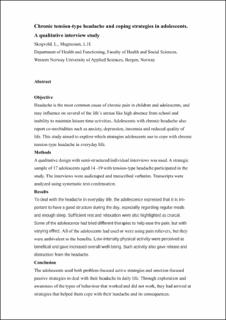| dc.contributor.author | Skogvold, Lars | |
| dc.contributor.author | Magnussen, Liv Heide | |
| dc.coverage.spatial | Norway | en_US |
| dc.date.accessioned | 2020-06-03T05:51:30Z | |
| dc.date.available | 2020-06-03T05:51:30Z | |
| dc.date.created | 2019-06-30T16:28:44Z | |
| dc.date.issued | 2019 | |
| dc.identifier.citation | Skogvold, L., & Magnussen, L. H. (2019). Chronic tension‐type headache and coping strategies in adolescents: A qualitative interview study. Physiotherapy Research International, 24(3). | en_US |
| dc.identifier.issn | 1358-2267 | |
| dc.identifier.uri | https://hdl.handle.net/11250/2656251 | |
| dc.description | This is the peer reviewed version of the following article: Skogvold, L., & Magnussen, L. H. (2019). Chronic tension‐type headache and coping strategies in adolescents: A qualitative interview study. Physiotherapy Research International, 24(3), which has been published in final form at https://doi.org/10.1002/pri.1778. This article may be used for non-commercial purposes in accordance with Wiley Terms and Conditions for Use of Self-Archived Versions. | en_US |
| dc.description.abstract | Objective
Headache is the most common cause of chronic pain in children and adolescents and may influence on several of the life's arenas such as high absence from school and inability to maintain leisure time activities. Adolescents with chronic headache also report co‐morbidities such as anxiety, depression, insomnia, and reduced quality of life. This study aimed to explore which strategies adolescents use to cope with chronic tension‐type headache in everyday life.
Methods
A qualitative design with semistructured individual interviews was used. A strategic sample of 17 adolescents aged 14–19 with tension‐type headache participated in the study. The interviews were audiotaped and transcribed verbatim. Transcripts were analysed using systematic text condensation.
Results
To deal with the headache in everyday life, the adolescence expressed that it is important to have a good structure during the day, especially regarding regular meals and enough sleep. Sufficient rest and relaxation were also highlighted as crucial. Some of the adolescence had tried different therapies to help ease the pain but with varying effect. All of the adolescents had used or were using pain relievers, but they were ambivalent to the benefits. Low‐intensity physical activity was perceived as beneficial and gave increased overall well‐being. Such activity also gave release and distraction from the headache.
Conclusion
The adolescents used both problem‐focused active strategies and emotion‐focused passive strategies to deal with their headache in daily life. Through exploration and awareness of the types of behaviour that worked and did not work, they had arrived at strategies that helped them cope with their headache and its consequences. | en_US |
| dc.language.iso | eng | en_US |
| dc.publisher | Wiley | en_US |
| dc.subject | adaption | en_US |
| dc.subject | adolescence | en_US |
| dc.subject | coping | en_US |
| dc.subject | headache | en_US |
| dc.subject | psychological | en_US |
| dc.title | Chronic tension-type headache and coping strategies in adolescents: A qualitative interview study | en_US |
| dc.type | Peer reviewed | en_US |
| dc.type | Journal article | en_US |
| dc.description.version | acceptedVersion | en_US |
| dc.subject.nsi | VDP::Medisinske Fag: 700::Helsefag: 800::Fysioterapi: 807 | en_US |
| dc.source.pagenumber | 1-7 | en_US |
| dc.source.volume | 24 | en_US |
| dc.source.journal | Physiotherapy Research International | en_US |
| dc.source.issue | 3 | en_US |
| dc.identifier.doi | 10.1002/pri.1778 | |
| dc.identifier.cristin | 1708877 | |
| cristin.ispublished | true | |
| cristin.fulltext | postprint | |
| cristin.qualitycode | 2 | |
